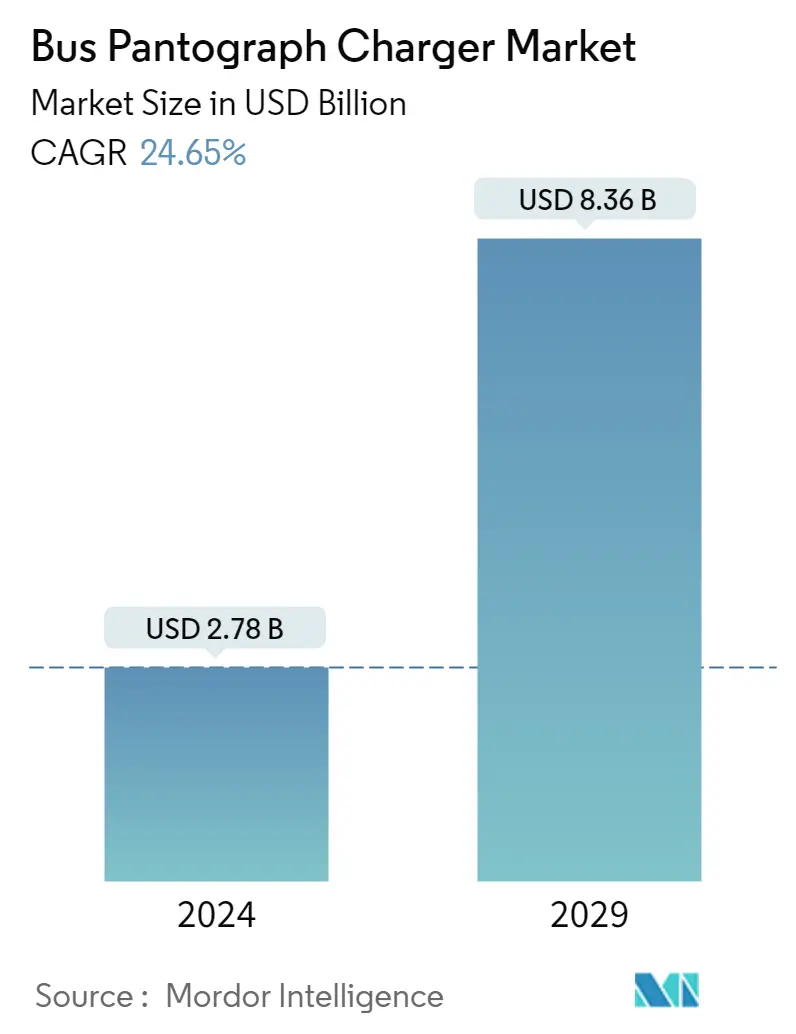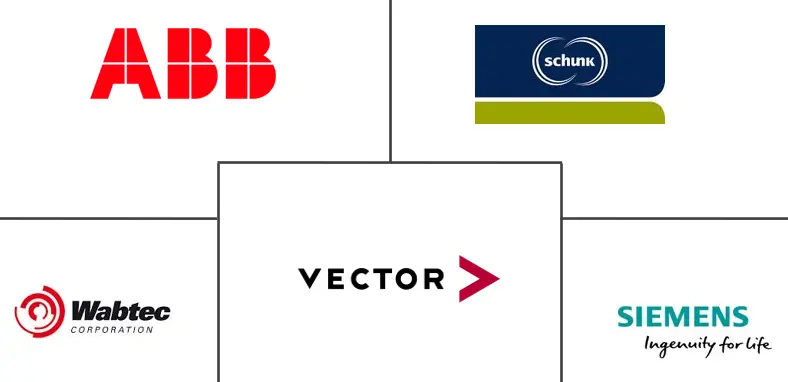Market Size of Bus Pantograph Charger Industry

| Study Period | 2020 - 2029 |
| Market Size (2024) | USD 2.78 Billion |
| Market Size (2029) | USD 8.36 Billion |
| CAGR (2024 - 2029) | 24.65 % |
| Fastest Growing Market | Europe |
| Largest Market | North America |
| Market Concentration | Medium |
Major Players
*Disclaimer: Major Players sorted in no particular order |
Pantograph Bus Charger Market Analysis
The Bus Pantograph Charger Market size is estimated at USD 2.78 billion in 2024, and is expected to reach USD 8.36 billion by 2029, growing at a CAGR of 24.65% during the forecast period (2024-2029).
COVID-19 has severely affected the bus pantograph charger market for the first half of the year 2020, as lockdowns and restrictions resulted in reduced demand from transportation and other associated sectors. Furthermore, delays in electric bus projects and supply chain disruptions worsened the situation in the market. However, the majority of the automakers and EV charging providers resumed pantograph charger production with limited production and necessary measures. The sales of electric buses witnessed significant growth since the latter half of the year 2020 and are likely to continue during the forecast period. This is anticipated to drive the market in focus during the forecast period.
Over the medium term, the demand for pantograph chargers is expected to be picked up by the growing adoption of electric buses, not only for transit but also for school children's transportation across major countries in the world. Furthermore, growing government investments and their focus on improving charging infrastructure are expected to drive demand in the market during the forecast period. Moreover, a new development in the charging station market by the companies is also expected to support the growth. For instance,
- In October 2021, Custom Denning, one of Australia's leading bus manufacturers, chose Siemens to provide its Sicharge UC management solution and charging stations. The technology, which is currently being tested, will aid the manufacturer's upcoming electric buses. It can operate at up to 1,000 volts and has a power range of 50 to 600 kW.
In addition, investments from the key players and growing strategic collaborations between charging solution providers and bus manufacturers are anticipated to offer new opportunities for players operating in the market. There is a surge in the utilization of electric bus charging systems owing to the decreasing cost of batteries. The growing efforts to reduce greenhouse gas (GHG) emissions, along with the rise in favorable government regulations, are likely to enhance the growth of the market over the forecast period. For instance,
- In June 2022, the Pacific Economic Development Agency of Canada, in collaboration with British Columbia's Minister of Transportation and Infrastructure, announced a USD 31,2 million investment plan under their joint federal funding for improving public transportation services in British Columbia. The upgrade includes the construction of new transit interchanges as well as the electrification of the bus fleet.
North American region is expected to grow at a significant rate during the forecast period owing to the rising adoption of electric buses across major countries in the region. Furthermore, China and India are expected to contribute to growth in the Asia-Pacific region owing to strong encouragement from the governments, transit agencies, as well as other green vehicle-supporting communities and organizations.
- In March 2021, the Delhi government approved a proposal to purchase 300 new low-floor electric (AC) buses to increase the city's bus fleet. These buses have been accepted by the Delhi Transport Corporation. The first batch of 118 buses was scheduled to arrive in October 2021, with another 100 following in November. The entire delivery was supposed to be finished by January 2022.
Pantograph Bus Charger Industry Segmentation
A pantograph, which makes automated contact between the bus and the charging infrastructure, is a common way to charge battery electric buses. There are currently two methods for making this contact. When charging is required, the pantograph can be mounted on the roof of the electric bus and lifted, or it can be mounted on the charging infrastructure and moved downwards.
The bus pantograph charger market is segmented by charging type (level 1, level 2, and direct current fast charging (DCFC)), component type (hardware and software), charging infrastructure (off-board top-down pantograph and on-board bottom-up pantograph), and geography (North America, Europe, Asia-Pacific, and Rest of the World). The report offers market size and forecasts for the bus pantograph charger market in value (USD million) for all the above segments.
| By Charging Type | |
| Level 1 | |
| Level 2 | |
| Direct Current Fast Charging |
| By Pcomponent Type | |
| Hardware | |
| Software |
| By Charging Infrastructure Type | |
| Off-board top-down pantograph | |
| On-Board Bottom-Up Pantograph |
| Geography | ||||||||
| ||||||||
| ||||||||
| ||||||||
| ||||||||
|
Bus Pantograph Charger Market Size Summary
The bus pantograph charger market is poised for significant growth over the forecast period, driven by the increasing adoption of electric buses globally. The market, which experienced a downturn due to the COVID-19 pandemic, has rebounded as automakers and EV charging providers resumed production. The resurgence in electric bus sales is expected to propel the demand for pantograph chargers, supported by government investments and initiatives aimed at enhancing charging infrastructure. Key developments, such as Siemens' collaboration with Custom Denning in Australia, highlight the ongoing advancements in charging technology, which are anticipated to further stimulate market growth. Strategic collaborations between charging solution providers and bus manufacturers, along with decreasing battery costs and favorable government regulations, are also contributing to the market's expansion.
North America is expected to be a significant contributor to the market's growth, with the United States leading due to various government initiatives and the rising popularity of electric school buses. The region's active efforts to transition to electric mobility, supported by substantial investments and projects, are encouraging the adoption of pantograph chargers. Similarly, Asia-Pacific countries like China and India are witnessing growth due to strong governmental support for green vehicles. The market is moderately consolidated, with major players like ABB Ltd., Wabtec Corporation, and Schunk Transit Systems GmBH employing strategies such as product innovation and strategic partnerships to strengthen their market position. These developments, coupled with global efforts to promote sustainable public transportation, are expected to create a positive momentum for the bus pantograph charger market.
Bus Pantograph Charger Market Size - Table of Contents
-
1. MARKET DYNAMICS
-
1.1 Market Drivers
-
1.2 Market Restraints
-
1.3 Industry Attractiveness - Porter's Five Forces Analysis
-
1.3.1 Threat of New Entrants
-
1.3.2 Bargaining Power of Buyers/Consumers
-
1.3.3 Bargaining Power of Suppliers
-
1.3.4 Threat of Substitute Products
-
1.3.5 Intensity of Competitive Rivalry
-
-
-
2. MARKET SEGMENTATION (Market Size in Value - USD Million)
-
2.1 By Charging Type
-
2.1.1 Level 1
-
2.1.2 Level 2
-
2.1.3 Direct Current Fast Charging
-
-
2.2 By Pcomponent Type
-
2.2.1 Hardware
-
2.2.2 Software
-
-
2.3 By Charging Infrastructure Type
-
2.3.1 Off-board top-down pantograph
-
2.3.2 On-Board Bottom-Up Pantograph
-
-
2.4 Geography
-
2.4.1 North America
-
2.4.1.1 United States
-
2.4.1.2 Canada
-
2.4.1.3 Rest of North America
-
-
2.4.2 Europe
-
2.4.2.1 Germany
-
2.4.2.2 United Kingdom
-
2.4.2.3 France
-
2.4.2.4 Italy
-
2.4.2.5 Spain
-
2.4.2.6 Rest of Europe
-
-
2.4.3 Asia-Pacific
-
2.4.3.1 India
-
2.4.3.2 China
-
2.4.3.3 South Korea
-
2.4.3.4 Japan
-
2.4.3.5 Rest of Asia-Pacific
-
-
2.4.4 South America
-
2.4.4.1 Brazil
-
2.4.4.2 Aegentina
-
2.4.4.3 Rest of the South America
-
-
2.4.5 Middle East and Africa
-
2.4.5.1 Saudi Arabia
-
2.4.5.2 South Africa
-
2.4.5.3 Rest of the Middle East and Africa
-
-
-
Bus Pantograph Charger Market Size FAQs
How big is the Bus Pantograph Charger Market?
The Bus Pantograph Charger Market size is expected to reach USD 2.78 billion in 2024 and grow at a CAGR of 24.65% to reach USD 8.36 billion by 2029.
What is the current Bus Pantograph Charger Market size?
In 2024, the Bus Pantograph Charger Market size is expected to reach USD 2.78 billion.

